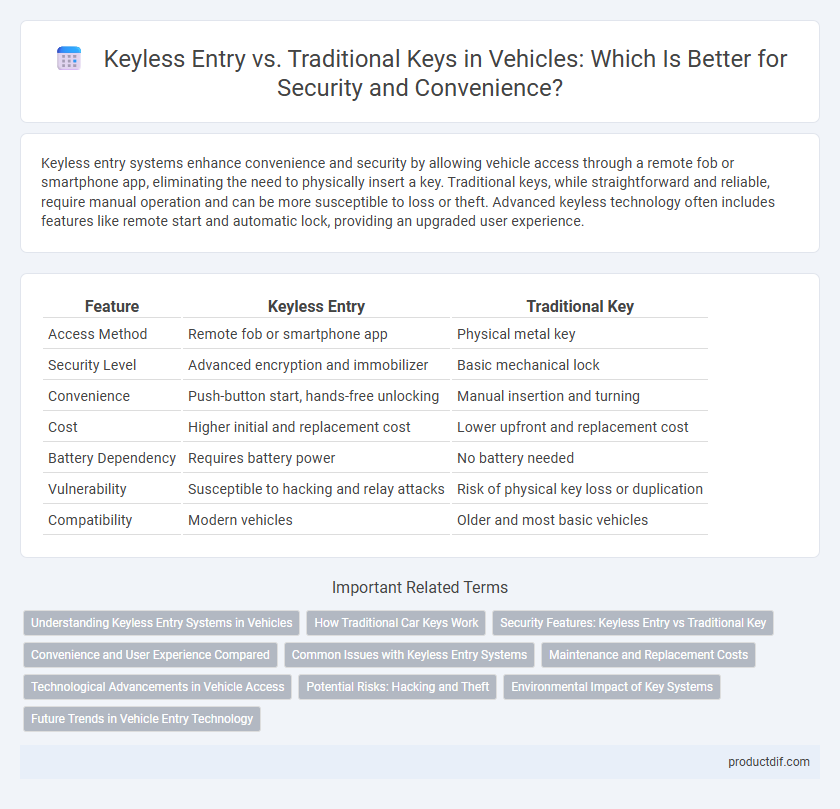Keyless entry systems enhance convenience and security by allowing vehicle access through a remote fob or smartphone app, eliminating the need to physically insert a key. Traditional keys, while straightforward and reliable, require manual operation and can be more susceptible to loss or theft. Advanced keyless technology often includes features like remote start and automatic lock, providing an upgraded user experience.
Table of Comparison
| Feature | Keyless Entry | Traditional Key |
|---|---|---|
| Access Method | Remote fob or smartphone app | Physical metal key |
| Security Level | Advanced encryption and immobilizer | Basic mechanical lock |
| Convenience | Push-button start, hands-free unlocking | Manual insertion and turning |
| Cost | Higher initial and replacement cost | Lower upfront and replacement cost |
| Battery Dependency | Requires battery power | No battery needed |
| Vulnerability | Susceptible to hacking and relay attacks | Risk of physical key loss or duplication |
| Compatibility | Modern vehicles | Older and most basic vehicles |
Understanding Keyless Entry Systems in Vehicles
Keyless entry systems in vehicles utilize radio frequency identification (RFID) technology to communicate between a key fob and the car's locking mechanism, enabling drivers to unlock doors without physically inserting a key. These systems improve convenience and security by allowing remote access and ignition, often featuring encryption protocols to prevent hacking. Compared to traditional keys, keyless entry reduces wear and tear on locks and provides enhanced functionality such as passive entry and push-button start.
How Traditional Car Keys Work
Traditional car keys operate through a mechanical system that physically rotates the ignition cylinder to start the engine. The key's unique cuts align with the internal pins of the lock cylinder, enabling the door or ignition to turn only if the correct key is inserted. This mechanical security contrasts with electronic keyless entry systems that rely on remote signals and sensors.
Security Features: Keyless Entry vs Traditional Key
Keyless entry systems enhance vehicle security by using encrypted signals and rolling codes to prevent unauthorized access, reducing risks of lock-picking and key duplication common in traditional keys. Traditional keys rely on physical locks that can be susceptible to picking, bumping, or theft, offering less protection against advanced tampering techniques. Advanced keyless entry also integrates with immobilizers and alarm systems, providing multi-layered security compared to the single-layer protection of traditional mechanical keys.
Convenience and User Experience Compared
Keyless entry systems offer enhanced convenience by allowing drivers to unlock and start their vehicles without physically handling a key, reducing time and effort during daily use. Traditional keys require manual insertion and turning, which can be less efficient, especially in low-light or adverse weather conditions. The seamless interaction of keyless technology improves the overall user experience by providing quick access, personalized settings, and added security features.
Common Issues with Keyless Entry Systems
Keyless entry systems in vehicles often face issues such as signal interference, which can prevent the remote from unlocking the car properly. Battery failure in the key fob is another common problem that renders the system temporarily unusable. Additionally, software glitches or sensor malfunctions may cause inconsistent locking and unlocking, requiring technical support or system resets.
Maintenance and Replacement Costs
Keyless entry systems typically require specialized electronic components and battery replacements, leading to higher maintenance and repair costs compared to traditional keys. Traditional keys and mechanical locks generally incur lower costs due to their simpler design and widespread availability of parts. Over time, keyless systems may demand costly technician services for reprogramming or module replacement, making them more expensive to maintain than conventional keys.
Technological Advancements in Vehicle Access
Keyless entry systems utilize wireless technology and encrypted signals to grant vehicle access without physical keys, enhancing convenience and security through features like remote locking and push-button start. Traditional keys rely on mechanical locks and physical insertion, which can be prone to wear and unauthorized duplication. The integration of smart sensors and mobile app connectivity in keyless entry represents a significant leap in vehicle access technology, reducing theft risks and improving user experience.
Potential Risks: Hacking and Theft
Keyless entry systems increase the risk of relay attacks, where thieves intercept and amplify signals to unlock vehicles without detection. Traditional keys, while less convenient, offer stronger protection against electronic hacking due to their mechanical nature. However, both methods remain vulnerable to physical theft if proper security measures are not enforced.
Environmental Impact of Key Systems
Keyless entry systems reduce the need for physical keys, lowering metal and plastic waste associated with traditional key manufacturing. The electronic components in keyless systems contribute to e-waste but enable enhanced vehicle efficiency through features like remote start and energy-saving locks. Production and disposal of traditional keys involve less electronic waste but higher material consumption, making keyless systems a more sustainable option when managed properly.
Future Trends in Vehicle Entry Technology
Advancements in vehicle entry technology are rapidly shifting towards biometric authentication and smartphone integration, surpassing traditional key and keyless entry systems in security and convenience. Emerging trends include facial recognition, fingerprint scanning, and encrypted digital keys stored on mobile devices, enhancing personalized access and anti-theft measures. As connected car technology evolves, seamless cloud-based entry and remote unlocking via smart home systems are becoming standard features in next-generation vehicles.
Keyless entry vs Traditional key Infographic

 productdif.com
productdif.com